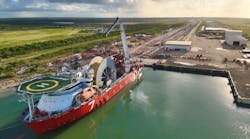Offshore staff
HOUSTON and PORTSMOUTH, UK– HWCG, a deepwater oil and gas emergency response consortium for the US Gulf of Mexico, has commissioned Magma Global to qualify m-pipe for a 350°F (177°C), 15,000-psig rated riser to augment its emergency well containment system.
The lightweight, flexible m-pipe section, HWCG claims, will enable a quicker response in shallow waters and for floating production facilities where vertical access may be a challenge.
The flexible riser would remain in a ready-for-deployment mode on the US Gulf Coast for deployment following a subsea well blowout. When installed to capture hydrocarbons it could remain in place for up to six months while a relief well is drilled.
The company says the design envisions approximately 800 ft (244 m) of m-pipe connected on one end to a ridged riser and on the other end to the incident well. The m-pipe will form a lazy wave between the two ridged ends thereby decoupling motions and improving operability. Using a temporary flowback solution, hydrocarbons are processed via the riser system and then collected in tankers for transportation.
The consortium requires the flexible section to be lightweight and easy to handle offshore to enable rapid deployment. It must also be resistant to degradation with continuous exposure to hydrocarbons at temperatures up to 350°F, pressures up to 15,000 psi (1,034 bar) and water depths of up to 10,000 ft (3,048 m). Magma will qualify a 6-in. nominal ID m-pipe specimen to meet the specified project requirements before manufacturing the final pipe order.
The consortium’s members have identified a range of potential demanding containment scenarios requiring high-pressure/high-temperature performance. HWCG selected m-pipe for its pressure and temperature performance, its lightweight and flexible properties which enable heave compensation at the base of a steel riser, because it is suitable for a wide range of fluids, provides low frictional resistance, and is resident to abrasion.
01/30/2019




